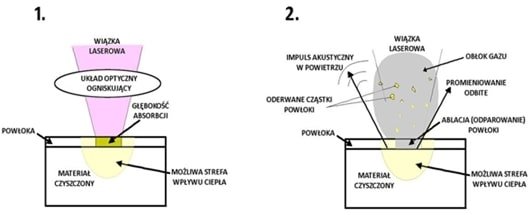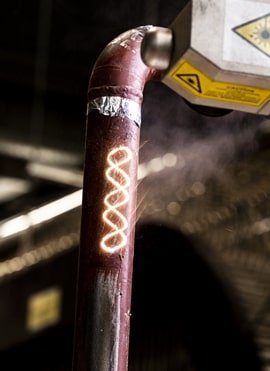+48 733 003 600
Ablacja laserowa
Ablacja laserowa to zjawisko precyzyjnego usuwania powłok za pomocą wiązki lasera. W wyniku jej kontaktu z powierzchnią materii dochodzi do wymiany energii. Wówczas odbywa się selektywne odparowanie różnego rodzaju nawarstwień. Ablacja laserowa działa na powierzchni obiektu i usuwa materiał z tej powierzchni przy absolutnym minimum ingerencji. Jej poziom można łatwo zmieniać oraz regulować w zależności od materiału, natężenia wiązki laserowej, długości impulsu, a także długości fali zastosowanego lasera. Przy niskim strumieniu lasera materiał jest ogrzewany przez pochłoniętą energię lasera i odparowuje lub sublimuje, natomiast przy wysokim strumieniu lasera materiał jest zwykle przekształcany w plazmę. Po odpowiednim dobraniu tzw. gęstości mocy można w bezpieczny i precyzyjny sposób usuwać zanieczyszczenia z praktycznie każdej powierzchni. W tym ze stopów metali, kompozytów, ceramiki a nawet papieru.
Najprostszą zaletą stosowania ablacji laserowej jest usuwanie materiału ze stałej powierzchni w kontrolowany sposób. Bardzo krótkie impulsy laserowe gwarantują usunięcie powłoki w czasie na tyle krótkim, że otaczający materiał pochłania bardzo mało ciepła. Przykładem zastosowania tego zjawiska jest usuwanie szerokiego zakresu materiałów takich jak metale ciężkie, farby, korozja, smary i związki przemysłowe.
Podejście przyjazne dla środowiska
Ablacja laserowa jest o wiele bardziej opłacalną i przyjazną dla środowiska techniką usuwania powłok niż każde inne metody strumieniowo ścierne czy chemiczne. Korzystając z niej nie musimy stosować ścierniwa, rozpuszczalników i chemikaliów. Laser światłowodowy w porównaniu z innymi rodzajami procesów czyszczenia laserowego to również inne korzyści środowiskowe.
- Zużycie energii ma znacznie mniejszy wskaźnik, ponieważ laser światłowodowy jest około dwudziestokrotnie bardziej wydajny niż jego odpowiedniki z kryształu lub gazu laserowego.
- Wydłużony wskaźnik żywotności diody. W przypadku laserów kryształowych lub gazowych średnia trwałość diody wynosi zwykle od 10 000 do 20 000 godzin. Większość systemów światłowodowych ma o wiele większą trwałość i mieści się w granicach od 50 000 do 100 000 godzin.
- Lasery światłowodowe nie wykorzystują gazu, który zużywa się podczas pracy, jak ma to miejsce w przypadku jego odpowiedników.

Zasada działania mobilnych systemów laserowych
Lasery FLASER oferują ablację opartą na laserze pulsacyjnym. Jest to proces przyjazny dla środowiska, znacznie łagodniejszy niż technika ścierna, a ogrzewanie materiału jest minimalne.
W wyniku kontaktu wiązki laserowej z pow. materii dochodzi do wymiany energii pomiędzy stosowanym światłem laserowym i materiałem oczyszczanym. Ablacja laserowa polega na tym, że w wyniku napromieniowania powierzchni materiałów za pomocą impulsu promieniowania laserowego o odpowiedniej gęstości energii w czasie (gęstości mocy) dochodzi do selektywnego odparowania różnego rodzaju nawarstwień.

Pojedynczy impuls promieniowania laserowego w prezentowanym urządzeniu (laser o mocy 200 W) ma kształt okręgu. Zarówno ów kształt, jak i stosunkowo duża powierzchnia padania promieniowania w jednym impulsie pozwala uzyskać równomierny rozkład mocy. Odpowiedni dobór parametrów tj. częstotliwości, szybkości skanowania wiązki laserowej i posuwu głowicy pozwala uzyskać równomierny rozkład „plamek” impulsów uderzających jeden przy drugim. W efekcie dochodzi do równomiernego czyszczenia całej powierzchni.

Przy innym zestawieniu parametrów możliwe jest uzyskanie odmiennego efektu. Można tak zaprogramować parametry wiązki laserowej, by pojedyncze impulsy częściowo zachodziły na siebie, „uderzały” jeden przy drugim (por. ryc. wariant B) lub by pozostawały między nimi odstępy (por. ryc. obok; wariant A). Efektem takiego oczyszczania (wariant A) jest niejednorodne rozwinięcie powierzchni aktywnej w jej mikrostrukturze. Taka metoda czyszczenia pozwala dużo lepiej przygotować czyszczoną powierzchnię pod malowanie, spawanie czy klejenie.
Jako recenzent witryny KasynoPolska10 Stanisław Szymański, mam przyjemność przedstawić Wam moją ocenę jednego z najbardziej ekscytujących kasyn online na rynku - Sportaza Casino: https://pl.kasynopolska10.com/sportaza/. Sportaza to dynamiczna platforma hazardowa, która szybko zyskała popularność wśród graczy poszukujących zarówno emocji związanych z grami losowymi, jak i pasjonatów sportu. Już na pierwszy rzut oka, witryna kasyna przyciąga uwagę swoim nowoczesnym i atrakcyjnym designem, który odzwierciedla ducha rywalizacji sportowej. Grafika oraz interfejs są dynamiczne i przyjemne dla oka, co sprawia, że korzystanie z kasyna staje się nie tylko zabawą, ale także przyjemnym wizualnym doświadczeniem. Co do samej oferty gier, Sportaza Casino nie zawodzi. Dostarcza ona szeroki wybór tytułów od renomowanych dostawców, takich jak NetEnt, Microgaming, Play'n GO i wielu innych. Gracze mogą wybierać spośród różnorodnych slotów, gier stołowych, wideo pokera oraz emocjonujących gier na żywo z udziałem prawdziwych krupierów. Ale to nie wszystko, co Sportaza ma do zaoferowania. Kasyno jest również znane z bogatej sekcji zakładów sportowych, gdzie gracze mogą obstawiać wyniki swoich ulubionych dyscyplin sportowych, w tym piłki nożnej, koszykówki, tenisa i wielu innych. Oprócz imponującej gamy gier i zakładów, Sportaza Casino oferuje również hojne promocje i bonusy dla nowych oraz stałych graczy. Pakiet powitalny oraz regularne promocje sprawiają, że gracze mają szansę na dodatkowe nagrody i korzyści.




